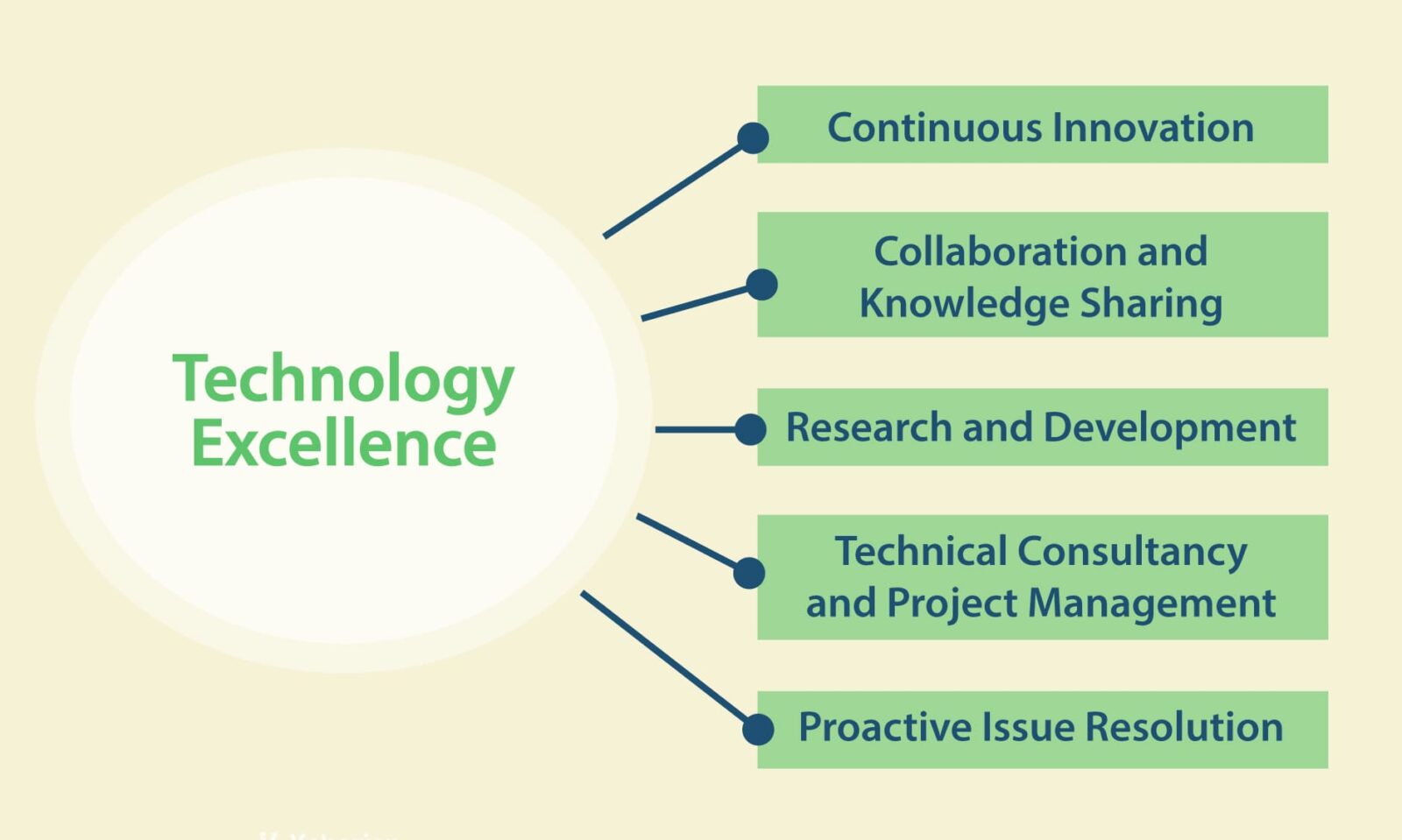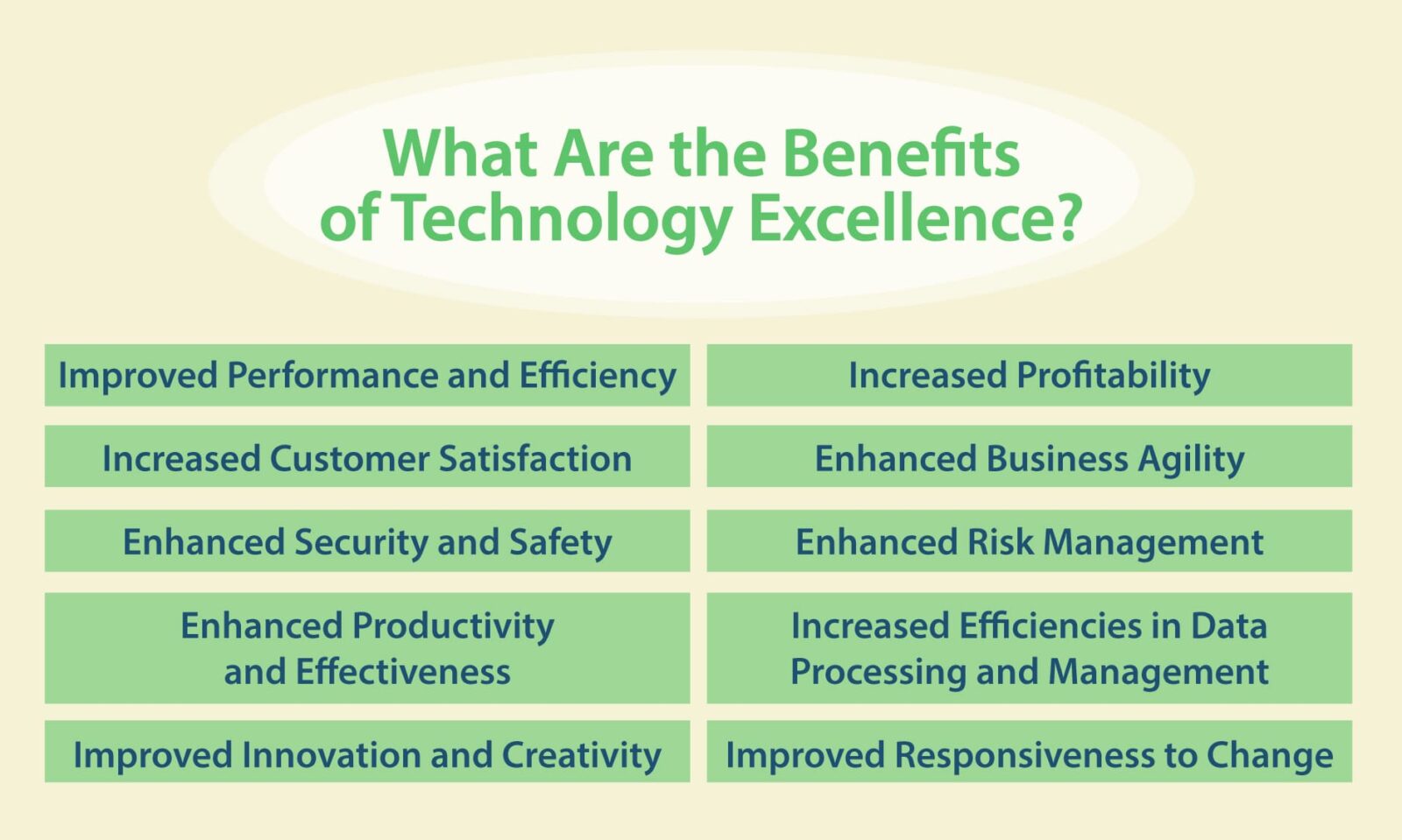Technology Excellence: The Key to Modernizing Your Business
Technology excellence is a crucial concept in the modernization of businesses. At its core, technology excellence involves leveraging the latest technological advancements and innovative approaches to drive efficiency, effectiveness, and growth. It goes beyond merely adopting technology; it encompasses the strategic use of technology to gain a competitive edge.

Technology Excellence Factors:
- Continuous Innovation: Technology excellence requires organizations to stay at the forefront of technological advancements and embrace innovation. This involves actively seeking out new technologies, exploring their potential applications, and finding innovative ways to leverage existing technology.
- Collaboration and Knowledge Sharing: Building a culture of collaboration and knowledge sharing is crucial. This involves establishing a companywide collaboration hub where project teams can discover new technologies and share insights and best practices. Through collaboration, organizations can harness the collective expertise of their workforce and drive innovation.
- Research and Development: Investing in research and development activities is crucial for achieving technology excellence. Establishing a dedicated Technology Centre of Excellence (TCE) can provide a platform for technical experts, architects, and project managers to conduct research, develop technical solutions, and provide training sessions to enhance the knowledge and skills of team members.
- Technical Consultancy and Project Management: The goal is to assist customers in solving urgent technical problems and evaluating team structures along with implementing the best methodologies and technologies for project success. This includes analyzing existing IT systems, recommending improvements, and training team members on the latest technologies and best practices.
- Proactive Issue Resolution: The capacity to anticipate and resolve problems before they have the potential to compromise safety, schedule, budget, quality, and customer happiness is a crucial component of technology excellence.
What Are the Benefits of Technology Excellence?
1. Improved Performance and Efficiency
- Enhanced collaboration through a companywide collaboration hub allows project teams to discover new technologies and innovative ways to use existing ones. This fosters a culture of continuous improvement and enables teams to build with greater efficiency.

- Further, technology excellence enables backend development teams to deliver quality software faster through practices like Test-Driven Development (TDD), Clean Architecture, and Clean Code. In addition to speeding up the software development process, this also ensures the delivery of high-quality software.
- Next, technology excellence can maximize efficiency in various industries – like the food and beverage industry – where tailored Enterprise Resource Planning (ERP) systems can streamline operations.
- By means of Power Apps, which is another example of technology excellence, businesses can create custom applications rapidly, which results in enhancing operational efficiency.
- Adopting a well-architected framework, based on pillars like operational excellence, security, reliability, performance efficiency, and cost optimization, can lead to improved technical excellence. In turn, this drives better performance and efficiency in the cloud environment.
2. Increased Customer Satisfaction
- With niche and highly in-demand capabilities, technology excellence enables businesses to gain superior knowledge and skill set in technology, so they can provide specialized services that cater to the unique needs of their customers. This helps address both the immediate and strategic goals of their customers, which enhances customer satisfaction.
- Additionally, technology excellence enables organizations to run their operations as efficiently as possible. Organizations may automate operations, streamline processes, and allocate resources more efficiently by utilizing cutting-edge technology tools and skills. This results in quicker reaction times, better service quality, and more overall effectiveness, all of which improve the customer experience.
- By embracing emerging technologies and adopting a forward-thinking mindset, organizations can proactively identify and implement improvements to their products, services, and processes. This continuous innovation keeps businesses relevant and ensures that they are able to meet the evolving needs and expectations of their customers, which leads to increased customer satisfaction.
- Also, technology excellence allows businesses to deliver a digitized and seamless banking experience. Aside from improving convenience for customers, it also enhances security and efficiency in banking transactions. Technologically advanced banking experience results in higher levels of customer satisfaction.
3. Enhanced Security and Safety
The following are key benefits of technology excellence for enhanced security:
- Improved Data Protection: Technology excellence enables businesses to implement state-of-the-art data protection measures like encryption, multi-factor authentication, and SSL protocols. For instance, organizations can leverage SSL to establish safe connections and transmit sensitive information securely. This minimizes the risk of unauthorized access or interception.
- Enhanced Risk Management: Through the use of advanced analytics, artificial intelligence (AI), and machine learning (ML), organizations can analyze vast amounts of data in real-time to detect patterns, anomalies, and potential threats. This enables timely intervention and proactive risk management.
- Strengthened Physical Security: Businesses can leverage technologies such as surveillance systems, access control systems, and biometric authentication to enhance physical security measures. These technologies enable organizations to monitor and control access to their premises, secure sensitive areas, and prevent unauthorized entry.
- Efficient Compliance Management: Technology excellence offers tools and practices that automate compliance management processes, reducing the risk of human error and ensuring adherence to standards. This not only enhances security but also helps organizations avoid penalties and reputational damage.
- Robust Disaster Recovery: These strategies are great at ensuring business continuity in the face of unforeseen events. Cloud computing, data backups, and redundant systems can minimize downtime and quickly recover from disruptions as well.
4. Enhanced Productivity and Effectiveness
By embracing technology excellence, your organization can streamline the processes, automate tasks, and improve collaboration, ultimately leading to increased efficiency and reduced errors. Which results in more productivity and fewer mistakes.
A well-architected framework can assist teams in creating applications, guaranteeing that non-functional needs like performance, dependability, and cost are taken into account right away. This method aids in avoiding costly errors like building an application for the cloud environment.
5. Improved Innovation and Creativity
Ensure that new technologies are aligned with customer needs and contribute to solving their problems. This customer-centric approach allows for the development of innovative solutions that address specific pain points and drive meaningful change.
A culture of continuous improvement and adaptability involves staying abreast of new technologies and their potential applications. Thus, organizations can remain flexible to changes and progressive opportunities. This agility enables them to embrace cutting-edge innovations. This leads to enhanced creativity and out-of-the-box thinking.
Also, technology excellence encourages collaboration and knowledge-sharing. Your teams may communicate, share ideas, and draw on one other's knowledge through platforms like the SHIFT Innovation Ecosystem and the corporate collaboration center. Creativity is stimulated by this collaborative setting.
6. Increased Profitability
It’s all about profitability. How does technology excellence drive profitability for businesses?
- Enhanced Efficiency: Technology enables businesses to automate processes, streamline operations, and eliminate manual tasks. This increased efficiency translates into cost savings, reduced labor expenses, and improved productivity.
- Improved Customer Experience: With technology, businesses can tailor their service platforms and customer portals, providing personalized experiences that meet customer needs. Due to recurring business and strong word-of-mouth recommendations, this raises customer happiness and loyalty, which ultimately results in improved profitability.
- Competitive Advantage: Companies gain an advantage in the market by staying current with the newest tech stack and knowledge. Businesses can set themselves apart from rivals and draw in more clients by utilizing niche and in-demand competencies, which will improve market share and profitability.
- Scalability and Flexibility: Whether it's through cloud-based solutions, agile project management, or value stream management, technology excellence allows companies to respond swiftly to market trends. This agility ensures that businesses can seize new opportunities, enter new markets, and optimize their operations for maximum profitability.
- Cost Reduction: The aim is to identify cost-saving opportunities and optimize resource allocation. For instance, implementing ERP systems or asset management solutions can streamline inventory management, reduce waste, and minimize operational costs.
- Data-Driven Decision-Making: Harness the power of data analytics and intelligence tools to gain valuable insights into customer behavior, market trends, and operational performance. This data-driven approach allows you to make strategic decisions.
7. Enhanced Business Agility
Enhanced business agility refers to an organization's ability to quickly and effectively respond to market changes, customer demands, and emerging opportunities. This enables organizations to adapt, innovate, and stay competitive in the market.
Few examples here:
- Rapid Response to Market Changes: Through the use of easy, quick, and adaptable adjustments to their products or services, technology excellence enables firms to quickly respond to market changes. Organizations can stay ahead of the competition thanks to their ability to adjust quickly to market demands.
- Improved Time-to-Market: Organizations can enhance overall efficiency by streamlining their development processes and concentrating on technology excellence. Shorter development cycles and quicker time to market for new products are the results of this.
- Enhanced Product Quality and Reliability: Agile engineering practices and following standardized approaches to prioritize nonfunctional requirements ensure that these aspects are built into the development process from the ground up, organizations can deliver high-quality products that meet customer expectations.
- Cost Optimization: By taking into account the financial implications of technological decisions and design choices, technology excellence aids companies in cost optimization. Organizations can balance performance and cost-effectiveness by weighing the costs of infrastructure, resources, and maintenance.
- Scalability and Flexibility: Businesses that place a high priority on technology excellence can create scalable, adaptable solutions that can expand and meet changing business needs over time. This can make sure their products or services have the ability to scale up or down as necessary by utilizing agile engineering principles.
8. Enhanced Risk Management
Robust compliance frameworks can automate and streamline compliance processes for enhanced risk management. For example, automation tools can be used to monitor regulatory changes, which ensures timely updates to policies and procedures. In addition to reducing the risk of non-compliance and potential penalties, this also promotes a culture of transparency.
To identify and mitigate risks, advanced analytics and real-time monitoring systems are essential. This can help gain valuable insights into potential risks and vulnerabilities. For instance, predictive analytics can help identify patterns and trends that may indicate a potential security breach or a compliance violation.
Implement proactive risk management strategies like robust cybersecurity measures or conducting regular security audits. Why? Protect your business from financial losses and reputational damage while enhancing their overall resilience.
9. Increased Efficiencies in Data Processing and Management
- Enhanced Speed: With technology excellence, organizations can leverage advanced technologies like AI, RPA, and cloud computing to process and manage data at a much faster pace.
- Improved Accuracy: Advanced data management systems and tools minimize errors and inconsistencies in data processing. By leveraging advanced algorithms and machine learning, organizations can achieve higher accuracy in data analysis.
- Scalability and Flexibility: With technology excellence, organizations can scale their data processing and management capabilities as per their evolving needs. This enables them to handle large volumes of data without compromising efficiency.
- Enhanced Security: Data protection measures (encryption, access controls, and authentication protocols) can ensure the confidentiality, integrity, and availability of data. As a result, the risk of data breaches and unauthorized access can be minimized.
- Cost Savings: Besides optimizing data processing and management workflows, technology excellence reduces the need for manual intervention and streamlining operations. Over time, this leads to cost savings.
10. Improved Responsiveness to Change
- Automation and orchestration tools
- Continuous integration and deployment (CI/CD) practices
- Cloud computing
- DevOps practices
- Real-time monitoring and analytics
- Collaborative software development platforms
- API-driven architectures
- Low-code or no-code development platforms
- Machine learning and artificial intelligence algorithms
- Data visualization tools
- Internet of Things (IoT) devices and sensors
- Chatbots and virtual assistants






